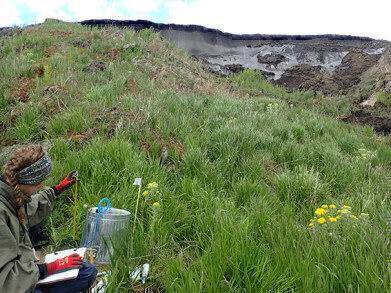-
 Researcher measuring nitrous oxide emissions on Kurungnakh Island
Researcher measuring nitrous oxide emissions on Kurungnakh Island
Air Monitoring
Novel source of the strong greenhouse gas nitrous oxide found in Siberian permafrost
Jan 19 2022
A previously unknown source of the strong greenhouse gas nitrous oxide has been found in East Siberian Yedoma permafrost. This observation was made by an international group of researchers, with the lead of researchers from the University of Eastern Finland.
Nitrous oxide (N2O) is the third-most important greenhouse gas after carbon dioxide and methane, and per unit mass an almost 300 times stronger warming agent than carbon dioxide. It is produced in soils as a result of microbial activity. The discovery of nitrous oxide release from the late-Pleistocene-aged Yedoma permafrost is important due to the large area of the Yedoma region, and its large carbon and nitrogen stocks and high ice content, which makes it vulnerable for abrupt thaw. The nitrous oxide emissions from thawing permafrost represent a poorly known, but potentially globally significant positive feedback to climate change. Overall, the consequences of nitrogen release from permafrost for Arctic ecosystems have been insufficiently studied and remain poorly understood.
In the study, the researchers measured nitrous oxide emissions from the riverbanks of the East Siberian rivers Lena and Kolyma, where rapid permafrost thaw exposes Yedoma permafrost to the surface, releasing large amounts of carbon and nitrogen for microbial activity. The researchers found that nitrous oxide emissions from recently thawed Yedoma were initially very low but increased within less than a decade to high rates, exceeding typical emissions from permafrost-affected soils by one to two orders of magnitude (10-100 times). The increase in nitrous oxide emissions was related to drying and stabilisation of the Yedoma sediments after thaw, and to associated changes in the microbial community participating in soil nitrogen cycle: the relative proportion of microbes producing nitrous oxide precursors (nitrate, nitric oxide) increased and the relative proportion of microbes consuming nitrous oxide decreased.
Usually, high nitrous oxide emissions occur from agricultural soils, where the availability of mineral nitrogen is high because of nitrogen fertilisation and other management practices. Since the nitrogen cycling in cold Arctic soils is slow, they have previously been regarded as unimportant nitrous oxide sources. Based on accumulating evidence during the past years, however, this is not always true: nitrous oxide release has been found to be a common phenomenon in permafrost-affected soils, and the emissions increase with warming, disturbed vegetation cover and permafrost thaw.
“The nitrogen release from thawing permafrost can substantially improve the availability of nitrogen in Arctic ecosystems, which, in addition to the direct climatic feedback in the form of nitrous oxide, may have important consequences on carbon fixation by plants and eutrophication of water systems,” says Postdoctoral Researcher Maija Marushchak from the University of Eastern Finland, the lead author of the study.
Digital Edition
IET 34.2 March 2024
April 2024
Gas Detection - Biogas batch fermentation system for laboratory use with automatic gas analysis in real time Water/Wastewater - Upcycling sensors for sustainable nature management - Prist...
View all digital editions
Events
Apr 22 2024 Hannover, Germany
Apr 22 2024 Marrakech, Morroco
Apr 23 2024 Kuala Lumpur, Malaysia
Apr 23 2024 Kintex, South Korea
Apr 23 2024 Edmonton, AB, Canada

















